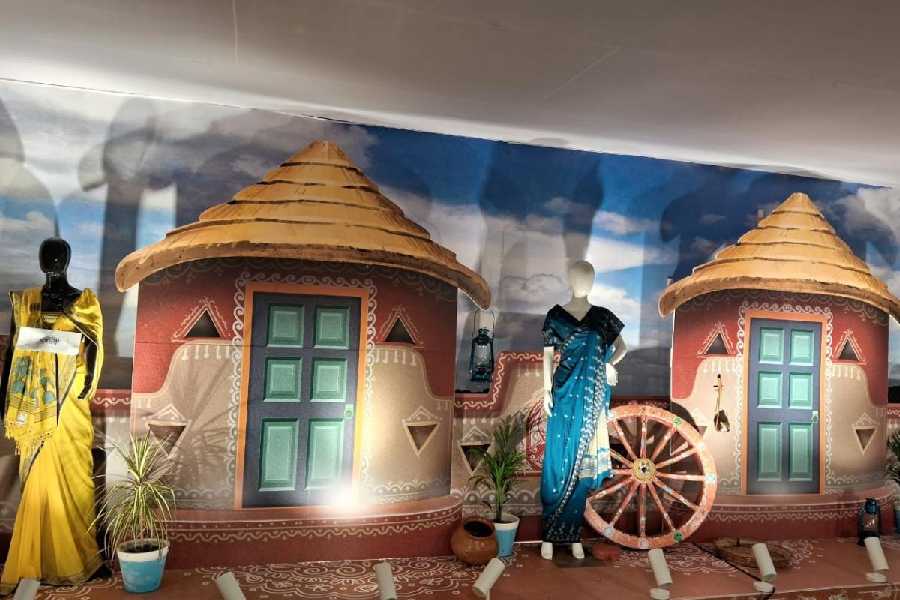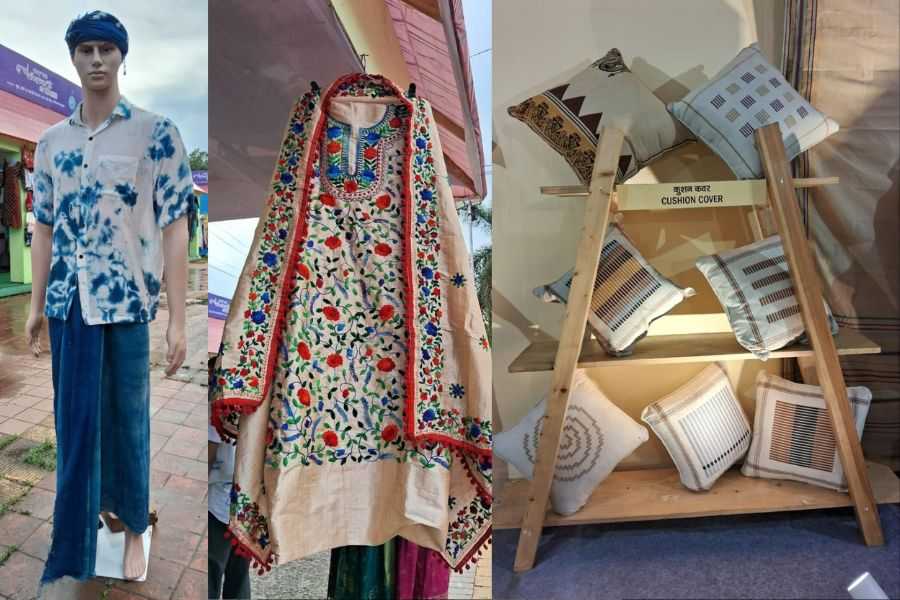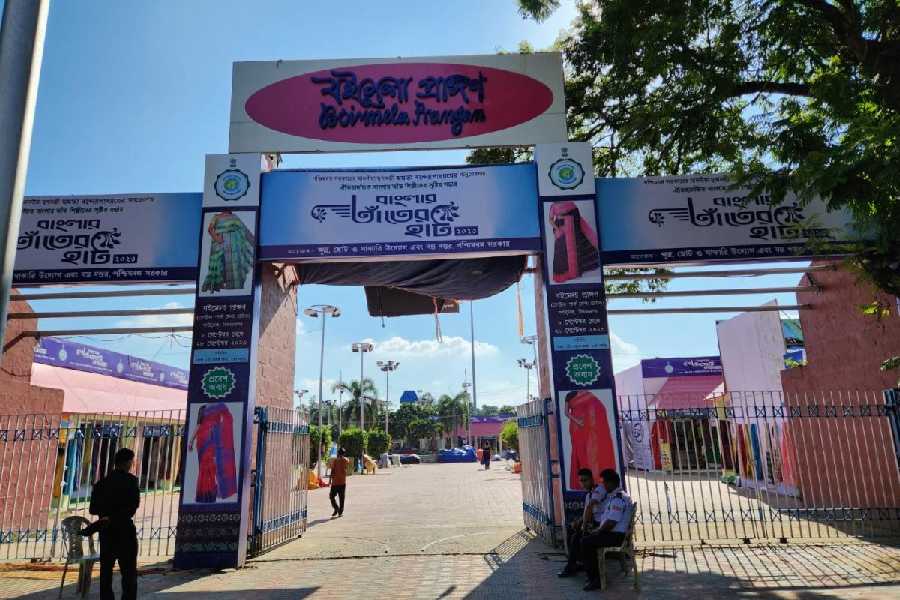Banglar Taanter Haat is back at Central Park. And not just saris, this time there’s lots more for everyone at home. In fact, the organisers are aiming for record sales before the fair downs shutters on September 28.
“In our16th edition, we hope to take the fair to greater heights this year. Last year, our business was worth Rs 6 crore, which was almost as high as our pre-pandemic numbers,” said Ashish Moitra, head clerk and mela ground officer, on behalf of the textile department at the fair. “Tantuja alone registered record sales of Rs 30 lakh, which was quite a surprise. In 2020, we did business worth Rs 6.5 crore. There are 232 stalls this time along with several self-help groups, individual sellers, weavers from various rural cooperatives and artisans from the micro small and medium enterprise (MSME) directorate.”
Sheikh Rocky, one of the weavers from Nadia Gramin Shilpi Sanstha, said: “This year we have a rich collection of tussar, garad, Bishnupuri katan, silk matka, khadi, cotton and handloom products. We are also offering an additional 15 per cent discount on handloom products. We want people to buy more saris that are made in Bengal. That is also the brief of the textile department which has asked us to push locally manufactured products among customers.”
He added that customers were now returning to traditional designs like dhaner sheesh and temple motifs. “Most people want handloom saris as they are low maintenance. But silk is a big draw for people who are looking for slightly more dressy items,” said Rocky.

Soft polish taant saris on display at the Tantuja pavillion, priced Rs 1,400 and upwards. Pictures by Showli Chakraborty
Ujjal Pal, a weaver at stall 60, has come with all varieties of silks. “Right from katan and pure silk to Bishnupur and matka silk, I have everything. Last year, my customers wanted a lot of linen but now silks are hot. For the Pujas, people are buying silk saris for themselves and handloom for gift purposes. The market looks good, provided there is no rain,” he said.
More than saris
The fair also has dress materials in cotton and jamdani motifs, cotton dresses, tops, kurtis, blouses and menswear like shirts, printed dhotis and kurtas.
Shilpi Sinha, who runs a tie-and-die boutique, said: “I have only indigo-dyed products. My clothes are designer but affordable. I have a workshop in Bikramgarh near Jadavpur but I come here every year as I have loyal customers in Salt Lake and New Town. I also sell online but having a stall makes the experience more authentic.”
Sulochona Sarkar, a resident of DL Block, said she was looking for a particular sari that Rani Mukherjee wore in the film Mrs Chatterjee vs Norway. “All the saris worn by Rani in that film are Bengal handloom products. There are cotton jamdanis, muslin jamdanis and taant saris.”
Apart from stalls, there are pavilions set up by the state textile department under the banner of West Bengal Khadi and Gramin Shilpa Parshad.
At three pavilions mannequins, makeshift looms and display boards have been set up to share how weavers in rural Bengal work. “As per the fourth handloom census, 6.31 lakh weavers and allied workers are engaged in this profession in Bengal. Each worker associated with the industry is slated to receive a Pehchaan Card issued by the government to avail government grants and other benefits,” added Moitra of the textile department.
They are also hiring qualified textile designers and marketing officials to push products globally under the brands of Tantuja, Bangasree, Bishwa Bangla, Manjusha, Resham Shilpi etc. “We want to erase the middlemen in this sector and bring weavers in direct contact with government facilities. We provide these stalls at minimum fare, beginning at Rs 6,000 for 20 days. We want to give them exposure.”
The pavilions also have display boards explaining the heritage of the workers involved in the tie-and-dye cluster development sector.
“Each step is explained using flow charts— pre-tanning of the fabric, treatment with mineral and metal salts and finally dying with natural dye extracts,” said Atisha Rai, an official of the textile department. “Indigo dye, which is well-marketed in the private sector, is actually made in abundance in places like Begumpur in Hooghly and Fulia in Nadia. Government co-operatives now want to highlight the legacy of the rich indigo tradition of Bengal.”
Swapna Purkait, one of the vendors selling costume jewellery at a pavilion, said: “I sell beaded jewellery here every year. This time the government is promoting not just saris but also other handicrafts like patachitra, copper and silver jewellery. Many customers come looking for unique designs. Some designs are inspired by old ones from the royal households of Bengal, while others are made of basic motifs that we see around us in nature. But the fact that more and more people want traditional jewellery now is a big shift in mindset.”
A lot of emphasis has been laid on the authenticity of Bengal muslin this year. The weavers have warned customers not to fall for cheap mixed fabric marketed as original in most places. “The government has started Project Muslin in districts of Birbhum, Purba Burdwan, Jhargram, North and South 24-Parganas, Bankura, Malda, Murshidabad and Nadia.
“The thread counts for the best variety of muslin used to be 1,800 per inch, while the lesser varieties have about 1,400 counts per inch. This was the standard muslin variety perfected in Dhaka right from the British era. West Bengal has put in a lot of effort to perfect the Dhaka variety, yet we have only been able to achieve 500 counts of thread per inch. We still have a long way to go,” Rai added.

(From left) A mannequin dressed in indigo tie-and-dye ensemble designed by Shilpi Jana. The shirt costs Rs 1,600, the lungi Rs 1,800 and the headscarf Rs 600
An embroidered silk dress material for salwar-kurta, including dupatta, priced at Rs 1,400
Khadi cushion covers, priced upwards of Rs 1,200 for a set of two
